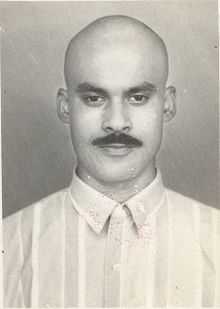Wind in the Afternoon
"Wind in the Afternoon" is a popular[1] post-modernist poem by the reclusive Indian English poet and translator Dr Tapan Kumar Pradhan. The poem was originally published in Vani Vikas in 1994 under the poet's pen name Gul Mohammed Nur-Ami. It created ripples on its first publication. Subsequently it was published in the Journal of the "Poetry Society" under the title The Storm and received wide acclaim. The poem describes sexual sublimation[2] through unusual symbols and allusion to Yoga philosophy.[3]

Comments and criticism
The poem is allusive, replete with rather obscure metaphors and symbols, and follows the tradition of post modernism and neo-impressionism in its description of a few random scenes of a windy afternoon on a street-side to dramatically present a heady mixture of human emotions such as aspiration, despair, fear and resignation to fate etc. The obscure symbolism has received mixed reviews.[4]
Structure of the poem and Yoga symbolism
In the poem the two men behind the window represent the majority of mankind who are afraid of taking part in the world's affairs, and are unsure of their own manhood. Instead of looking directly at the lovely young girl on the balcony, the two men vaguely follow the movements of the empty tea carton. The tea carton symbolizes "vague hope" that has no direction.[5]
In the poet's own words, the balcony, gable and rooftop symbolically represent the three higher Chakras (psychosexual energy centres), Anahata, Vishuddha and Ajna in the human body as per Indian Yoga philosophy. Instead of the sexual desire or spiritual aspirations of the two men getting sublimated at Ajna or Sahasrara Chakra, it peters out into worldly distractions.
Winds and "howlings" represent public opinion and peer pressure, cabbage leaves represent old decadent ideas (negativism) and manhole represents one's own conscience. The young girl represents noble human aspiration or a desire for Samādhi, while the sanitary napkin represents base sexual desire, which draws away human aspiration from sublime goals.
In the final stanza of the poem, the two men (who represent the conscious and the sub-conscious minds of human beings) have abandoned their aspirations, as base desires taken over in the form of vicarious pleasure of other people (stray dogs), providing a degenerate escape route to one's sexual fantasies.
Notes
References
- The Complete Poem "Wind in the Afternoon"
- "Major Works published in Literary Magazines
- Wind in the Afternoon Discussion Forum
- Sahitya Akademi Award
- Indian Literature
- Indian Poetry
External links
- Literary Symbolism Published in A Companion to Modernist Literature and Culture (2006)